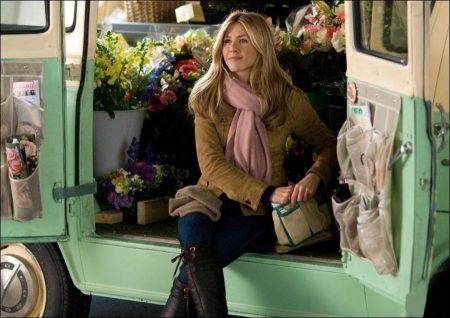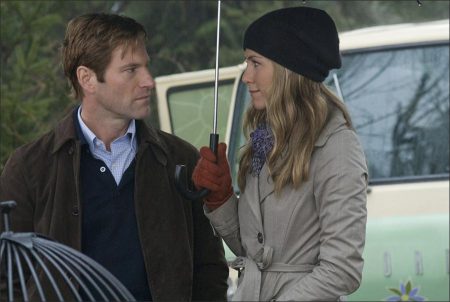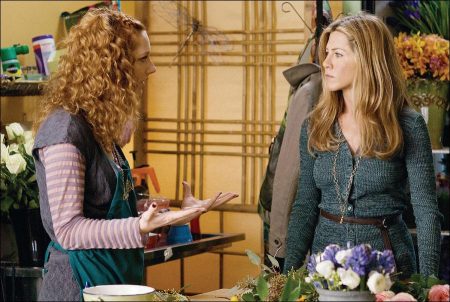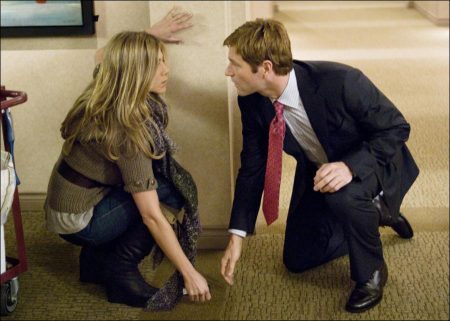Love Happens Movie Trailer. Eckhart liked the screenplay for Love Happens and signed on to the project. Of his interest in joining, he says: “I loved the romance part of the script with Jennifer Aniston’s character, Eloise. Burke has many things going on in his own life. His wife died three years earlier, and it took everything he had to deal with that pain and loss. Now he’s helping other people to deal with their pain. He is a complex character in that he preaches one thing but doesn’t live what he preaches. Though he’s still a good, sincere guy.”
Of his aspirations for the film, Eckhart states: “I hope the audience will find the romance to be fun and energetic, sweet and charming. I think they’ll find the grieving part of it to be heartfelt, sincere and touching. I feel that we have an obligation to treat grief and those who are grieving with a lot of respect, compassion and empathy.”
When Thompson and Camp wrote the character of Burke’s love interest, Eloise, they imagined a woman who was also very broken. Again and again, she keeps falling for the wrong guy. Thompson notes: “Eloise is drawn to Burke due to her own dysfunction; her father abandoned Eloise and her mother when Eloise was very young. In many ways, she emulates Burke’s character. She has to go through this journey with him to come to the realization there is somebody good and positive in her life.”
Jennifer Aniston was cast as the free-spirited florist who sets in motion a profound change for Burke just as he helps her to move on. “Jennifer is radiant on screen and she’s so watchable,” says Camp. “Eloise is a character with whom you never know what you’re going to get. She writes on walls, pretends to be deaf, is quirky and eccentric, and has this girl-next-door quality about her. It doesn’t feel forced with Jennifer… that human notion of being just a little left of center, being a little bit different. As much as she’s a movie star, she’s also so relatable and accessible.”
When she read Love Happens, Aniston was interested in the dynamic between two lost people in a screenplay that was, as she puts it, “not your typical love story. It’s about two people who are starting a scary, new beginning.” Describing Eloise’s world before Burke, the actress offers: “So far in life, she’s content in the choices that she’s made.” But when she meets the self-help guru, “Eloise sees an opportunity to fix something, and Burke is looking to be healed. For him, it’s the first time he’s allowed his heart to feel. When you do that, you have to clean out the skeletons, whether you want to or not.”
Though she’d not previously worked with Eckhart in a film, she felt her co-star was ideal for the role of the grieving widow. “You can’t imagine anyone else playing Burke,” Aniston commends. “Aaron is spoton and moves you so much. I found him extremely dedicated and focused. When you work with a performer like that, you constantly have someone giving you something good to volley with.”
Stuber was glad to have Aniston back. In 2006, the two worked with Vince Vaughn on the producer’s first blockbuster, The Break-Up. “Working with Jen again was terrific,” commends Stuber. “During our last film, she gave every bit of herself to perfect her moments…be they comedy or drama. She has great complexity as an actress. She’s rare in that she has great comedic timing and real emotional depth.”
Tony Award-winning actor Dan Fogler came aboard as Burke’s literary manager, Lane, whose megastar ambitions for Burke (and himself) entail a major corporate deal with a TV show. The filmmakers were wary of turning the character of Lane into a hackneyed archetype. Fogler took the role and blew away their expectations of who Lane could be.
Offers Stuber: “Dan has this effusive energy, which is good because Aaron’s character has to be a bit more reserved. Lane’s got heart to him, too, which is the beauty of his character. We’ve seen the clichéd manager-agent who’s just a killer. But this is a guy who’s Burke’s friend; they’ve done this together, and he obviously wants to be successful. But most importantly, he wants his friend to be happy. The humanness that Dan brought to the character is a virtue of the movie. Dan made the character real.”
“Love Happens was a different kind of story for me,” adds Fogler. “It had a lot of big issues in it, like surviving the death of a loved one. There’s something appealing about this character. Lane’s dream is to become the global visionary that he thinks he is. If Burke succeeds, then Lane will succeed. He’s like a ball of stress in the entire movie, constantly playing mother to Burke.”
Long known for stealing scenes in such comedies as 27 Dresses, 13 Going on 30 and The Wedding Planner, Judy Greer was cast as Marty, Eloise’s wild co-worker who chastises her about her love life.
Marty thinks (correctly) that Eloise has a pattern of choosing unavailable men. For her role, the actress was able to take what was on the page and create a unique improv dialogue. “At first, Marty is not a big fan of the Burke-Eloise relationship,” notes Greer. “She has her own issues, because she was pretty badly hurt in a relationship and has turned into a militant feminist. Marty feels like Eloise’s mom-a nurturer and a caregiver. She says it like it is, and tries to shake Eloise out of her reverie.”
The performer gave the filmmakers more than they expected of the character. Says Thompson: “Marty’s a bit more aware of Eloise’s dysfunction than Eloise is and calls her out on it. The energy and physical comedy that Judy brings, in addition to the lines she literally made up, are fantastic. Everything this woman does is funny.”
John Carroll Lynch, most recently seen in Clint Eastwood’s Gran Torino, was brought on to the project as reluctant workshopper Walter Mayfield. Lynch reflects on what drew him to the role: “The script appealed to me because I found it emotionally messy and complicated. I like scripts that aren’t wrapped up so neatly that you walk away thinking everything is perfect.”
He continues: “There’s a kind of circus quality to these kinds of self-help seminars. They really play on your emotions. It’s like a revival meeting, and Walter doesn’t buy any of that. He’s affected by Burke’s dealing with the loss of his own wife-more than the hot coals or the field trips into the streets of Seattle. It’s not the bells and whistles that get these people through. What does that is seeing how other people in grief actually work through it. The irony is that Burke is having the same journey as Walter is and, in some ways, he is a little behind him. ”
Multi-award-winning performer Martin Sheen was cast as Burke’s father-in-law, who becomes the catalyst to force Burke to confront what he’s been running away from for the past three years. Stuber sums up what the cast and the crew felt about Sheen’s participation: “This was a dream for all of us. Martin was who we had hoped to get in that part from day one. He’s an icon, and we are all enormous fans. We just kept coming and coming and coming at him to get him to agree.” He jokes, “I think we wore him down into doing the movie. He might have even said, `I’ll do it so I don’t have to hear from you people anymore.’”
After he read the screenplay, Sheen was happy to take the part. The actor offers: “The biggest appeal of the story is that it’s one of redemption, a story of how we come to accept ourselves as human. And part of being human is being broken. Most of us are broken sometime during the journey that we’re given to travel. When we are able to focus on the brokenness and heal ourselves and each other, then we become strong.”
Rounding out the main cast is Rocky, a 20-year-old, white-feathered, yellow-crested parrot also known as APOLLO. Burke eventually releases Rocky into the wild-a promise he’d made to his now-deceased wife. But getting rid of Rocky for good proves harder than anyone thinks.
To capture the film’s footage, director Camp’s crew shot in more than 30 locations over the course of production. The team worked eight weeks in Vancouver and one week in Seattle, the city in which the picture wrapped. Replicating Seattle in Vancouver was made possible through CGI enhancements, which added Mount Rainier and the Space Needle to the Vancouver horizon, while deleting the coastal Rockies from the background.
During its time in Vancouver, the production lensed in such locations as the Hyatt Regency and Marriott hotels, where Burke’s workshop seminar and roof scenes were shot; the Fraserview Cemetery; Home Depot, where the guru takes seminar attendees; Vancouver International Airport; several parks; and street locations in such cities as New Westminster, British Columbia.
In the pristine British Columbia rain forest, Camp captured scenes of Aaron Eckhart as Burke running through the misty glade on his way to set Rocky the parrot free, just as Burke had promised his wife he would do several years earlier. To provide the mist, the production team created a 600-foot-long smoke tube-facilitated by an 80-foot dolly track-that was draped along the forest floor.
For the exterior restaurant scene where Eloise and Burke have their first date, the crew had to time the shots to avoid recording the penetrating noise of “toots” that came every quarter hour from the heirloom steam clock in the trendy Gastown section of Vancouver.
As producer Thompson lives in Seattle, he wanted to give filmgoers an insider’s view of what one might experience on a trip to the city. Eckhart admits that he felt its demeanor right away. “Seattle has a certain mood that parallels the script,” says the actor. “The city has a weight to it that this film needs; it is serious enough for the subject. Whereas, if it were in Los Angeles, my character could be a little bit too slick.”
The joke during production was that the team had to do what few in Seattle thought would ever be necessary: create rain in a very wet city. For a scene in which Burke has a major revelation, the rain would pour down and soak the cast and crew. The rainmaking process entailed leveling a 40-ton crane truck parked on a 30-degree incline- propped up in front on wooden blocks to keep it even-with the front wheels suspended seven feet above ground.
The 110-foot boom dangled the 50- foot-long rain bar on a truss, with four rain heads dispensing 7,500 gallons of water from three water trucks and saturating an area of 50 by 100 feet. The four nozzles each had three rain heads, which could spew varying amounts of water, depending upon the needs of the crew. The rain bar was built and rigged the same day as the shoot, which began at 5:00 a.m. To prevent Eckhart from catching a chill from the 10 soakings, he was fitted with a neoprene suit under his business attire.
The deluge took place at the famed Pike Place Market, a fresh produce and artisan market in the city. To capture the scene, the production closed down the street for the day and shot the traffic jam with 80 cars-in addition to 200 extras-in the controlled downpour. The only person without an umbrella was the unfortunate Eckhart. A night scene was also filmed at the adjacent Gum Wall, where, in the spirit of the tradition, the crew added its own offerings to the sticky monument.
Additional key landmarks captured by Camp and cinematographer Eric Edwards during filming included the Space Needle and the Fremont Troll, which was sculpted under the Aurora Street Bridge by four Seattle artists in 1990. The troll is an 18-foot-high monster with a glaring metallic eye, and, according to local legend, lives on a diet of automobiles.
The 605-foot-high Space Needle, where the film wrapped, is perhaps the symbol of this Pacific Northwest city. Built for the 1962 World’s Fair, the Needle has a blustery observation deck that is deck, Eckhart stood nose-to-nose with a camera-equipped helicopter that pulled out to reveal the entire Needle, the Seattle night cityscape and harbor.
When production designer Sharon Seymour discussed the overall look of the film with Camp and the producers, the team imagined Burke inhabiting a restrained world. They agreed that he’s completely shut down before he meets Eloise. “Burke’s world is conference hotels, so we needed a very neutral space,” says Seymour. “A conference hotel doesn’t go out of its way to hit you over the head with any kind of particular color palette or huge design style.
“On the other hand, Eloise moves in a completely open, more Mediterranean and organic-colored world,” she continues. This world gets opened up to Burke when they visit the hookah bar, where he has a moment that expands his life and makes him think that life can go on. It’s a new way to look at the world and get out of the suppressed environment he’s been living in.”
A challenge for Seymour was to design an interesting and compelling environment in the banquet room, where Burke gives his “A-Okay!” seminar to fanatical attendees desperate to move on from losses of their own. She worked with Camp to create a visual environment that didn’t take attention away from Burke and his dynamic personality.
For the six-day seminar shoot-complete with 350 extras playing people desperate to learn the keys to letting go of their pain-the audiovisual presentation included two, 9 by 12-foot screens set up on either side of the stage with a spotlit center screen that displayed Burke’s “A-Okay!” logo. The operation included a full multimedia setup, with a camera projecting Burke’s image onto the screens, spots, a lighting board and a panel of computers.
Most agreed that the favorite set during production was Eloise’s Garden flower shop, a former lingerie store called Tabu that the art department completely dismantled and re-created as Eloise’s lush world. Producer Stuber voted that it was perhaps the “best-smelling set on which we’ve all worked.”
Incorporating a flower shop that Seymour believes is “an extension of Eloise’s character” was an idea that Camp and Thompson had long discussed. They were fascinated by the fact that over the course of florists’ lives, florists receive phone calls and orders from people across the world who-via the card that goes with their flowers-reveal some of the most vulnerable things one could ever say to a stranger.
“If you get exposed to that enough, it gives you a unique insight into the human experience,” says Thompson. “We thought that was a fascinating way to look at a character, and Eloise developed from this.” Eckhart elaborates: “The flowers are symbolic of Eloise’s striving to bloom, to nurture. They’re a symbol of love and forgiveness. For what Burke does in dealing with death, flowers are very comforting, soft, compassionate and symbolic.”
To make these elegant arrangements, the production required an enormous assortment of flora. Seymour was quite pleased when Teleflora signed on to assist her before shooting began. Its on-set consultant, MARIE ACKERMAN, helped the art department arrive at Eloise’s signature style.
The team used unusual, indigenous materials, earthy containers and a European-modern style for the designs in the shop. Her style, such as creating a display made entirely of limes, was unique. Most of the containers for the “hero” designs were made of layered birch bark to create a natural Seattle feel. Moss-covered lichen branches were added to the arrangements to convey the outdoor atmosphere of the Seattle area.
Ackerman also trained Jennifer Aniston and Judy Greer in the art of arranging flowers. To create authentic characters, she taught them to use floral tools, including a florist’s Swiss army knife, scissors, clippers and wire cutters. The consultant instructed Aniston on such tricks of the trade as holding the blade vertically (parallel to her thumb) and cutting the stem on an angle to preserve the cellular structure and allow the flowers to last longer.
In a pivotal scene at Burke’s seminar in which the self-help expert is trying to get through to the stoic Walter, Burke encourages him and other work-shoppers to demonstrate control by walking over glowing coals. “The tunnel of fire,” as Camp describes it, took two months to design.
Special effects expert JOHN SLEEP explains how Eckhart was able to walk on this fire without getting burned. Sleep and his crew acquired a sheet of Plexiglas that was 4 by 12 feet, and they placed lights under it to glow like coals. “We ground up boxes and boxes of real charcoal from burnt trees and used that as the charcoal base,” Sleep says. “Then we drilled holes through the Plexiglas for the smoke to come through.
“Fire was piped in through the edges, from 20 burners attached to propane tanks,” he continues. Next, the team created glowing coals for the workshoppers to walk over by placing tiny batteries and miniscule LED lights inside clear plastic painted to look like coals. A lighting system hooked to a lighting board from the Plexiglas made the coals flicker realistically.
As the fire walk generated a significant amount of heat, it had to be turned off between takes to prevent the plastic from melting or going soft. To protect themselves, the actors stuck moleskin to the soles of their feet. The result? Conquering fire through faith.
Love Happens (2009)
Directed by: Brandon Camp
Starring by: Jennifer Aniston, Aaron Eckhart, Dan Fogler, Judy Greer, Martin Sheen, Joe Anderson, John Carroll Lynch, Sasha Alexander, Clyde Kusatsu, Anne Marie DeLuise, Michelle Harrison
Screenplay by: Brandon Camp, Mike Thompson
Production Design by: Sharon Seymour
Cinematography by: Eric Alan Edwards
Film Editing by: Dana E. Glauberman
Costume Design by: Trish Keating
Set Decoration by: Lesley Beale
Art Direction by: Kendelle Elliott
MPAA Rating: PG-13 for language including sexual references.
Distributed by: Universal Pictures
Release Date: September. 18, 2009
Views: 154







